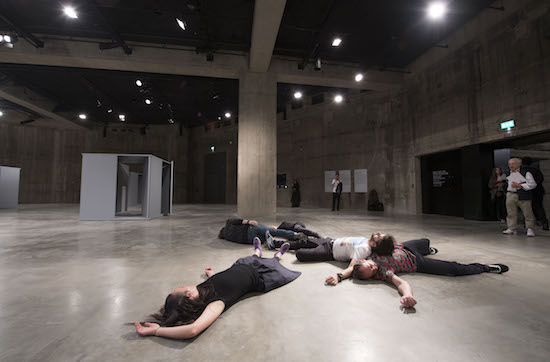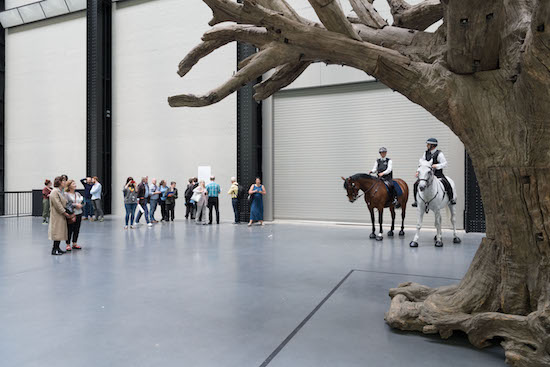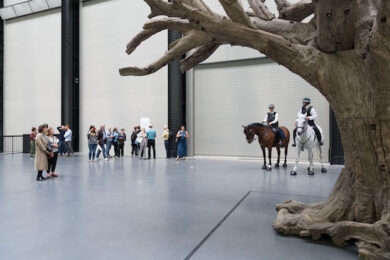Tania Bruguera (b.1968), Tatlin’s Whisper #5 2008, Performance, 2 people and 2 horses
Overall display dimensions variable, Tate. Purchased using funds provided by Alin Ryan von Buch 2009
© Tania Bruguera, Photo: Tate Photography
Arriving at the entrance of the new Tate Modern, two horses mounted by the police block the doors. My friend is oblivious. I tap her on the shoulder and she lets out a gasp, which assumes she’s not in on the performance. I inform her that it’s part of Tania Bruguera’s Tatlin’s Whisper. She laughs and tells me that she thought it was just a British custom; ‘the British police love striding around on horses’. This is of course the point of Bruguera’s performance: the almost unfalteringly omniscient presence of the police: their ability to divide, conquer and direct, their divisive contribution to creating a supposedly ordered society. As the horses block the entrance to the museum, I hear the policewomen dictate ‘please can all visitors use an alternative entrance’. The horse seemed to rear slightly as people approached. For a moment, it seemed unclear whether the request was part of the ‘performance’ or in fact a genuine request to ensure the horse remained calm. Visitors were both bemused and scared, snapping photos and moving out of the way in haste. The presence of the police was undesirably felt and I realised that it didn’t matter whether the request was ‘real’ or ‘performed’; the point is we listened and moved out the way.
Bruguera’s performance was acquired by Tate in 2009, and until now, has yet to have been staged since its acquisition. On the website, under medium, Tate lists ‘Two uniformed mounted policemen, crowd control police technique, two horses (one white, one black or dark brown), audience’. It is hard to imagine Tate’s conservation policy for such a work. It is also worth considering the time, resources and labour that makes such a performance possible. The efforts of human labour behind displaying performance is particularly visible throughout the museum for the opening – the exertion of performers working for hours on end, the presence of extra security staff and visitor assistants diligently informing visitors what is going on when they stumble upon two large horses. Watching this scene unfold, one is almost forced to consider how Tate will keep this up, or in fact, how can any museum, dedicated to the visibility of performance and live art, manage performance on a logistical day-to-day basis? Bruguera’s performance is not the only one to have been resurrected by the museum however. David Lamelas’s Time and Amalia Pica’s Strangers also took centre stage across the opening and will continue to do so into July. The new opening signals a gear shift, presenting itself as a museum ready, willing and excited to hold and stage performance. Tate has of course always been reasonably indebted to the visibility of performance in both the collection and programming, but the new opening is setting new precedents.
On the third floor of Tate’s new ‘Switch House’ sits the ‘Performer and Participant’ gallery. The rooms with works by Suzanne Lacy, Helio Oticica, Rebecca Horn and many others, promise to allow visitors to ‘discover how artists working between the 1960s and the 1990s opened up new spaces for participation’. At the heart of the galleries is the newly acquired Rhythm 0, by performance art superstar, Marina Abramovic. The objects displayed are haunting, challenging and alongside video documentation of the performance, force us to reconsider the trust that Abramovic placed in her then audience. My eyes automatically divert to the knives and then the gun, where I remember the story of an audience member who held it to Abramovic’s head. The still image of Abramovic naked, covered in lipstick and crying, stills itself into view – performance re-playing itself, imprinting itself through its documentation. Somehow the still, muted objects carry an enormous power – an unknown weight that signals the oft-troubled relationship between performer and participant.
Ana Lupas’s The Solemn Process consumes an entire room of the collection. The process ‘began as a traditional ritual involving communal craft work in rural Romania’. Beginning in 1964, Lupas began creating large straw structures with the help of villagers. Lupas, alongside a community volunteers used traditional weaving techniques to make these wreaths. At the outset, the process was a way to preserve local skills and continue a communal act of ‘making and displaying these objects in the local area.’ This process continued for many years but by the 1970s and with the Romanian economy in deep decline, it became difficult to maintain the creation of these objects on a yearly basis. Lupas soon turned her attention to preserving these objects. She originally tried to preserve them, drawing and sketching them and trying to restore them using tradition methods. However, this proved difficult and Lupas decided to crystallise them in time by wrapping the structures in metal ‘tins’. According to Tate, ‘this solution satisfied the artist as a practical means of preservation and a way of combining the natural and traditional ‘wreaths of wheat’ with modern, industrial associations through the metal casing.’

Alexandra Pirici & Manuel Pelmus, Public Collection, 2014, Copyright Alexandra Pirici & Manuel Pelmus, Photo: Tate Photography
Looking around the room, which sat at the heart of the Performer and Participant gallery, I found myself confronted with a startling metaphor for the relationship between performance and the museum. Lupas’s process seemed to ask the same questions that performance historians, curators and artists have been asking for many years: ‘how do we preserve this’? How do put a frame around these potentially (and not necessarily de facto) unstable objects? How do we continue to resuscitate or give life to actions? This awareness of performance’s relationship to the museum is at the heart of the new opening and the newly unveiled collection. Performance isn’t only offered to the audience as live performance, but we are shown objects, documents, costumes and scripts. Alexandra Pirici and Manuel Pelmuş’s Public Collection complicates and questions performance’s place in the museum further. Taking place in Tate’s south tank, four performers stand clasping their sides, they smile a honey sweet smile and move forward inch by inch. Surprised audience members then witness Vortez’s manifesto and a portrait of Marie Antoinette – the medium of the ‘original’ work is always announced, a humorous comment on the malleability and performativity of objects.
Visitors to Tate are seemingly perplexed by the work. People wandering casually around the museum on the opening weekend entered the room in a state of confusion as they witnessed one performer lie down, arching her legs to form Magritte’s The Treachery of Images. She announces that she is not a pipe. Clearly the audience members were aware that this performer was not a pipe. However, enacting Magritte’s work asks us to consider exactly what Magritte asked us to do in conceiving of this work. Whilst Public Collection is light-hearted, Pelmus’s and Pirici’s performance problematises the significance of images formed in other media and asks us to reshape the versions we have of them. Public Collection asks to consider whether these original works can ever have a stable semantic or spatial relationship to a visual image. And has this not always been the project of performance – to problematise and create ruptures with dominant ways of doing in the museum?
Walking back out into the rainy June afternoon, Herzog and de Meuron’s twisted structure began to make sense. It is a monolithic, crosshatched periscope, offering an alternative, curved perspective on the art it contains. Part of Tate’s mission with the Switch House was to offer new spaces for performance, live art and ephemeral practices and to presumably complicate how the museum relates to this medium in the first place. If we accept this as part of performance’s history and future, then Tate are handling it with care.
The Tate Modern Switch House is open now



